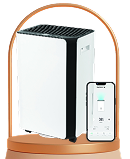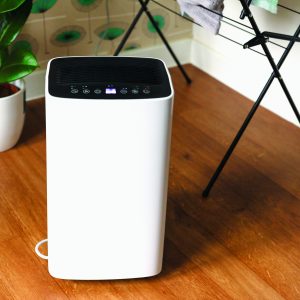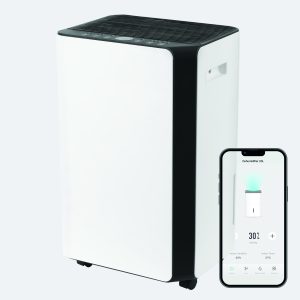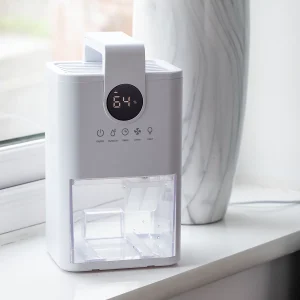
Managing indoor humidity is often overlooked, but it plays a critical role in creating a healthy, comfortable home, especially in the bedroom. In the UK, where dampness and condensation are all too common, using a dehumidifier can significantly improve your living environment. From preventing mould to enhancing sleep quality, the right dehumidifier offers both practical and wellness benefits. This guide will walk you through what a dehumidifier is, the different types suited for bedrooms, and how to choose one that meets your specific needs.
A dehumidifier is an electrical appliance designed to remove excess moisture from the air. In areas where humidity builds up—like bedrooms with poor ventilation or cold walls—a dehumidifier helps maintain healthy air quality by collecting water vapour and condensing it into a tank or draining it away.
Left unchecked, excess humidity can lead to mould, mildew, condensation on windows, musty odours, and even dust mite infestations. A dehumidifier not only combats these problems but also contributes to better sleep, cleaner air, and a more comfortable home.
When selecting a dehumidifier for bedroom use, understanding the internal technology is key to choosing one that fits your lifestyle, room conditions, and energy preferences. Here are the two main types:
Desiccant dehumidifiers use a chemical-based material—often silica gel—to absorb moisture from the air. This material sits on a rotating wheel or disc and continuously pulls water from the air as it passes through. A small built-in heater then dries the wheel, allowing it to be reused in a cycle, and the collected moisture is expelled into a tank or drained away.
This technology doesn’t rely on temperature differences to condense water, which means it works just as well in chilly environments. This makes it ideal for colder homes, older properties, or bedrooms that are poorly heated or face north (and therefore remain cold for longer).
Pros:
Cons:
Best for:
Cool or unheated bedrooms are best suited for a portable dehumidifier, making it ideal for winter use, allergy sufferers, and anyone needing compact portability.
Compressor dehumidifiers work similarly to a fridge. They draw in humid air and pass it over cold coils, causing moisture to condense into liquid form. The dry air is then reheated and released back into the room. Because the process depends on the air being warm enough to create condensation, these models perform better in rooms kept at moderate to warm temperatures (above 15°C).
These are the most common type of dehumidifier in the UK and are generally more energy-efficient when used under the right conditions.
Pros:
Cons:
Best for:
Modern or heated bedrooms, homes with central heating, daytime use, and year-round dehumidification where efficiency is a top priority.


Whether you live in a modern flat or a period property, moisture build-up is a common issue across UK homes, especially during colder months or in rooms with limited ventilation. Using a dehumidifier in your bedroom offers a range of health, comfort, and preservation benefits.
Humidity levels that are too high can make it difficult to breathe, disrupt body temperature regulation, and trigger allergies. A dehumidifier helps maintain the ideal indoor humidity range of 40–60%, creating a more breathable and comfortable environment for rest. For individuals with asthma, hay fever, or sinus issues, this can reduce night-time coughing, nasal congestion, and irritation. As a result, your ability to fall—and stay—asleep improves significantly, giving you deeper, uninterrupted rest thanks to the dry air from your small dehumidifier.
Bedrooms are particularly prone to mould growth, especially around windows, behind wardrobes, or along external walls where condensation collects. This is a common issue in UK homes with single-glazed windows or poor insulation. By keeping moisture levels in check, a dehumidifier halts the growth cycle of mould and mildew before it becomes a problem. This is not only essential for preserving the cleanliness of your room but also for protecting your health, as mould spores can aggravate respiratory issues and allergies.
Musty smells are a telltale sign of trapped moisture, particularly in bedrooms that lack regular airflow. These odours often settle into bedding, carpets, and wardrobes, creating a stale and unpleasant atmosphere. By reducing excess moisture in the air, a dehumidifier prevents odour particles from settling and allows the space to remain fresh-smelling. This improves not only the physical comfort of your room but also its psychological ambience, making it a much more inviting place to sleep and relax.
Excess humidity doesn’t just affect the air—it also seeps into your furniture and soft furnishings. Wooden wardrobes can swell or warp, mattress interiors can develop mildew, and even bedding may feel perpetually damp. A dehumidifier prevents these issues by keeping the air dry enough to avoid moisture accumulation in materials. This helps preserve the quality and lifespan of your furnishings, saving you from premature wear, discolouration, and the cost of replacements.
Dust mites and mould spores thrive in humid environments, and both are major triggers for allergies and asthma. By lowering indoor humidity, a dehumidifier creates an environment that is far less hospitable to these irritants. For those with sensitivities, this can result in noticeably fewer sneezing fits, itchy eyes, and wheezing at night, allowing you to wake up feeling more refreshed and less congested.
Stale, humid air can leave a room feeling stuffy and uncomfortable, particularly if windows remain closed to keep the heat in. A dehumidifier helps refresh the room’s atmosphere by removing excess moisture and promoting better airflow. Clean, dry air is not only more pleasant to breathe, but also supports long-term wellness and a consistently healthy sleeping environment.
Morning condensation on bedroom windows is a common issue, particularly during winter months when the outside air is cold and the bedroom is warmer. The moisture that collects on windows can drip down, damaging paintwork and encouraging mould growth on sills and frames. A dehumidifier helps eliminate this by reducing the amount of water vapour in the air, effectively preventing condensation from forming in the first place.
When shopping for a dehumidifier for your bedroom, it’s important to go beyond the basics and choose a model that matches your environment, habits, and comfort needs. Here are the essential features to keep in mind:
A dehumidifier provides a simple and effective way to improve air quality, protect your home, and support better sleep. Whether you’re dealing with window condensation, persistent musty smells, or allergies, the right unit can quietly transform your bedroom environment. With a wide range of features and models available, choosing one that aligns with your space, climate, and lifestyle is key. Invest wisely, and you’ll enjoy a drier, fresher, and healthier bedroom for years to come.





All rights reserved 2025